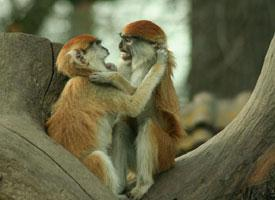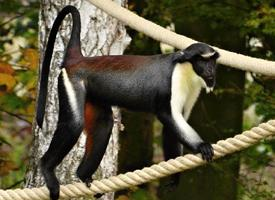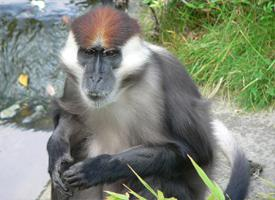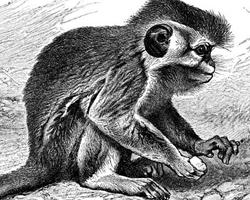
Váhy a míry
| Délka | 60 |
|---|---|
| Hmotnost | od 10 do 13 kg |
| Rychlost | 50 km/h |
Popis zvířete
The Common patas monkey, scientifically known as Erythrocebus patas, is a remarkable and distinctive species within the primate family. This species, often simply referred to as the patas monkey, is renowned for its unique physical appearance, fascinating behavior, and adaptability to various environments, making it a subject of interest among wildlife enthusiasts and researchers alike.Physical Characteristics:
The patas monkey exhibits several distinctive physical features that set it apart from other primates. Adults typically have a striking coat color that ranges from a light reddish-brown to a vibrant rust hue, which is more pronounced in males than in females. This coloration provides excellent camouflage within their natural savannah and grassland habitats. One of the most notable features of the patas monkey is its long limbs, particularly its hind legs, which are adapted for terrestrial locomotion. This adaptation makes it the fastest runner among primates, capable of reaching speeds up to 55 kilometers per hour (34 miles per hour) to escape predators. Their faces are framed with white fur, contrasting with a dark muzzle and a characteristic white mustache, giving them a distinct appearance. Adult males are significantly larger than females, with males weighing up to 13 kilograms (28.7 pounds) and females around 6.5 kilograms (14.3 pounds).
Behavior and Social Structure:
Patas monkeys exhibit intriguing social structures and behaviors. They are primarily diurnal, meaning they are active during the day. Their social groups, known as troops, typically consist of up to 60 individuals, although larger groups have been observed. These troops are often matriarchal, with females and their offspring forming the core of the group. Males usually lead a solitary life or form small bachelor groups, joining the female-led troops primarily during the mating season. Communication within the troop is vital and is facilitated through a variety of vocalizations, body postures, and facial expressions.
Diet and Habitat:
The diet of the patas monkey is omnivorous but predominantly herbivorous, consisting mainly of fruits, seeds, and insects. Their long limbs and terrestrial lifestyle allow them to cover large distances in search of food, making them less dependent on a single food source. Patas monkeys are adapted to live in a variety of dry habitats, including savannahs, semi-deserts, and open woodlands. They are primarily found in a broad belt across Africa, stretching from Senegal in the west to Ethiopia and Tanzania in the east.
Reproduction and Lifespan:
The reproductive cycle of the patas monkey involves a gestation period of approximately 5.5 months, after which a single offspring is usually born. Infants are highly dependent on their mothers for the first few months of life, during which they develop the necessary skills for survival. The lifespan of a patas monkey in the wild is around 12 to 20 years, although individuals in captivity can live longer due to the absence of predators and access to regular food and medical care.
Conservation Status:
The patas monkey is currently classified as Least Concern by the International Union for Conservation of Nature (IUCN), indicating that it is not presently at immediate risk of extinction. However, their populations are affected by habitat loss due to agricultural expansion, hunting for bushmeat, and capture for the pet trade. Conservation efforts are essential to ensure the long-term survival of this species, focusing on habitat preservation, anti-poaching measures, and education to reduce human-wildlife conflict.
In conclusion, the Common patas monkey is a fascinating primate with unique adaptations that allow it to thrive in some of Africa's harshest environments. Its striking appearance, complex social structures, and remarkable speed make it a standout species among primates. Despite its current conservation status, ongoing efforts are necessary to protect this species and its habitat for future generations to appreciate and study.
Podobná zvířata
Nové fotografie zvířat
Top 10 zvířat
- Chinese water dragon (Physignathus cocincinus)
- Galápagos tortoise (Geochelone nigra complex)
- Dolphin gull (Leucophaeus scoresbii)
- Japanese macaque (Macaca fuscata)
- Colombian red howler (Alouatta seniculus)
- Sea urchins (Echinoidea)
- Moustached guenon (Cercopithecus cephus)
- Diana monkey (Cercopithecus diana)
- Common reed warbler (Acrocephalus scirpaceus)
- Common house mosquito (Culex pipiens)


